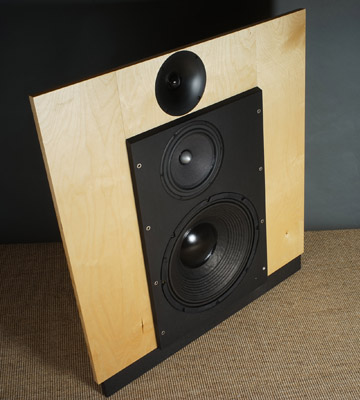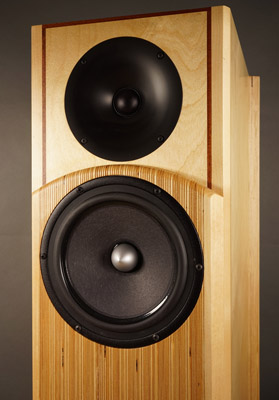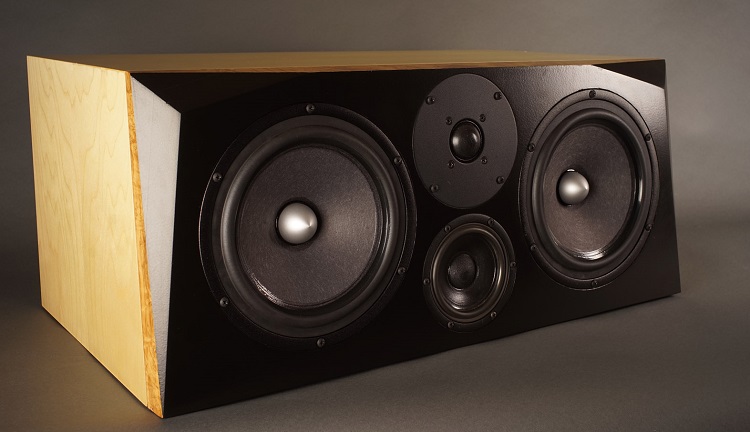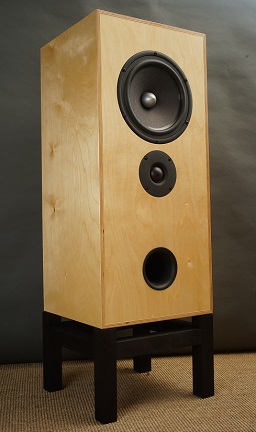DIY Loudspeakers: HOME INDEX UPDATES RESPONSE WHAT'S NEW
JA8008-HMQ
Copyright 2014-22 © Troels Gravesen
GO TO:
BASIC-FEATURES TS-DATA DIMENSIONS MEASUREMENTS BUY

It's been 6 years since I had the first
production samples of the
JA8008 driver and
quite a range of speakers have been made around this high-efficiency
driver:
TQWT,
DTQWT,
DTQWT-12,
QUATTRO,
8008-CENTER,
OBL-11 plus quite a few never published.
In particular the TQWT and DTQWT constructions have proven quite a
success and I dare say hundreds have been made. You may read response
from builders
here.
The new driver is JA8008-HMQ and the new main
speaker constructions are
TQWT-mkIII,
DTQWT-mkIII
and
DTQWT-212 mkIII
as former mkII constructions were based on a modified crossover. In
addition to this, SEAS T35 tweeter options were made having the same
crossover as the Audax TW034 versions.
For those SET lowers that need high impedance, the DTQWT can be used
with two Eminence 2510 bass drivers as used in the mkII version. Check
out DTQWT-mkIII file for details.
The old JA8008 driver is discontinued and should you by accident damage your
driver, there will be an up-dated crossover for those who want to stick
to the mkII design and not make the stepped baffle. Click link below (-mkIII-FLAT).
I really like the
QUATTRO speaker and one thing I learned from the project
was never to listen to requests. I had a couple of requests for a
smaller speaker using the 8008 driver. To my ears it turned out great
but very few have built it.
The
OBL-15
is the updated OBL-11 now using the new driver.
TQWT
is the same front set-up as the DTQWT, only without the 12" bass driver,
very suitable for small tube amps.
Should you want to up-grade your existing speakers with the new driver, look here for a kit allowing you to maintain a non-stepped front panel: http://www.troelsgravesen.dk/DTQWT-mkIII-FLAT.htm. A new crossover is required.
Standard tweeter is now the new SEAS T35C002, but AUDAX TW034 can be used with no changes to the crossovers. They will not sound exactly the same as the frequency response is not exactly the same, but this is not related to intrinsic quality, so please do not ask which one is best. The T35 tweeter was introduced because some people think old is bad and new is good and there's nothing I can do about it. There's another group of people who think old is good and new is bad, and I'm sure there will be arguments that the old JA8008 is better than the new JA8008-HMQ. Nothing I can do about this either.
The new JA8008-HMQ driver features:
BACK TO INDEX
Voice coil former: The voice coil available at that
time was wound on an aluminum voice coil former. Aluminum voice coil
formers introduce damping of cone movement by shorting eddy current
around the magnet gap. The result was low mechanical Q, actually 1.7, which is not too bad, but
one thing that can characterise vintage drivers is low
mechanical loss and a more vivid and dynamic presentation. I write
can characterise, because I've had vintage drivers that did not
have high Qm despite paper voice coil formers and "low-loss"
suspensions. Low-loss suspensions were sometimes added some viscous
resin to strengthen the suspension and ensure long-term stability - but
also had the impact of introducing a lot of damping to cone movement.
The aluminum voice coil former is now replaced by a fiber glass voice coil
former with similar properties of e.g. Kapton and titanium. The result
is an huge increase in Qm, actually I measure Qm = 10 from the driver
samples fitted with a center phase plug.
Surround: Foam surround is one of the best surround
materials available when it comes to low-loss suspensions. This
primarily due to low mass and excellent elastic properties, and when
applied a suitable coating it will also have a reasonable life-span.
What was not available back then (stock item) was foamed rubber*
surrounds as an alternative to coated foam. Foamed rubber provides lower
mass compared to the standard rubber used for bass drivers and in many
ways properties similar to foam surround. The new JA8008-HMQ is fitted
with a narrow (low mass) foamed rubber surround added a damping ring to reduce the
all too common ~800 Hz resonance.
*
Foamed rubber is not "foam" as one
reader suggested. Foamed rubber is rubber, only added compressed air
during molding to make a more porous structure and reduce weight.
What we usually refer to as "foam surrounds" is a plastic polymer
(polyurethane), quite
different from rubber.
Phase plug: Phase plugs were actually available at the
time the JA8008 was put together, but discarded as it did not offer any
sonic advantages to the paper dust cap. With the current driver the
phase plug offers the best frequency response and the highest mechanical
Q, thus phase plug it must be. The phase plug is held in place by a
solid copper ring above pole piece.
Magnet size: The magnet size has been increased on the
new driver to compensate for slightly increased mass of suspension and
loss of radiating area of cone (no dust cap) and we maintain an
efficiency of 94 dB/1W/1m making 95 dB/2.8V/1m sensitivity.
Not surprisingly the basic sound
of the new driver close to the old one (same cone), but due to new voice
coil former and low-loss supensions, you will notice an improvement in
transient response, transparency and low-level detail. Dust caps are
always a potential problem as they kind of live a life of their own and
often display some response in the treble range where they really
shouldn't. A very efficient way of dealing with this problem is not
having it at all and use a phase plug. The downside is loss of radiating
area (reduced efficiency) but the loss here is low as it is only a small
percentage of total radiating area and the added magnet size compensates
for the loss.
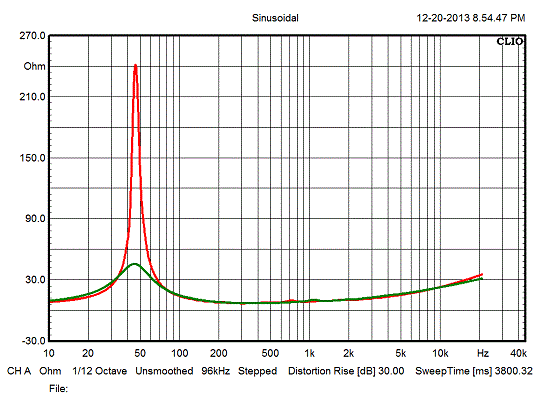
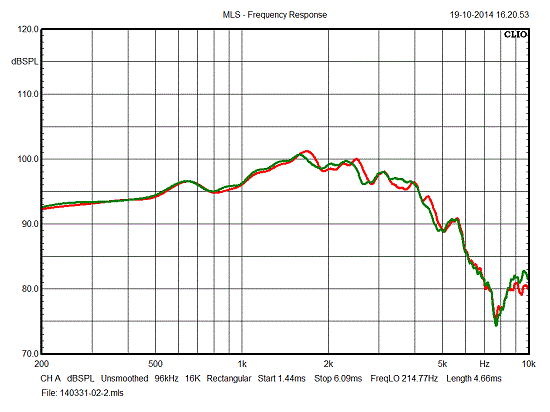
Above the two most important measurements: To
the left we see free air impedance plots of the old JA8008 (green) and
JA8008-HMQ (red). Due to the new voice coil former we see a huge peak at point
of resonance, which results in a whopping Qm = 10. This is what I wanted
- and even better than anticipated.
To the right we see the frequency response from two drivers mounted on a
28 cm wide baffle. Remember frequency response is highly dependent on
the shape and size of the front panel but I find a 28 cm baffle more
relevant than an infinite baffle in presenting a driver.
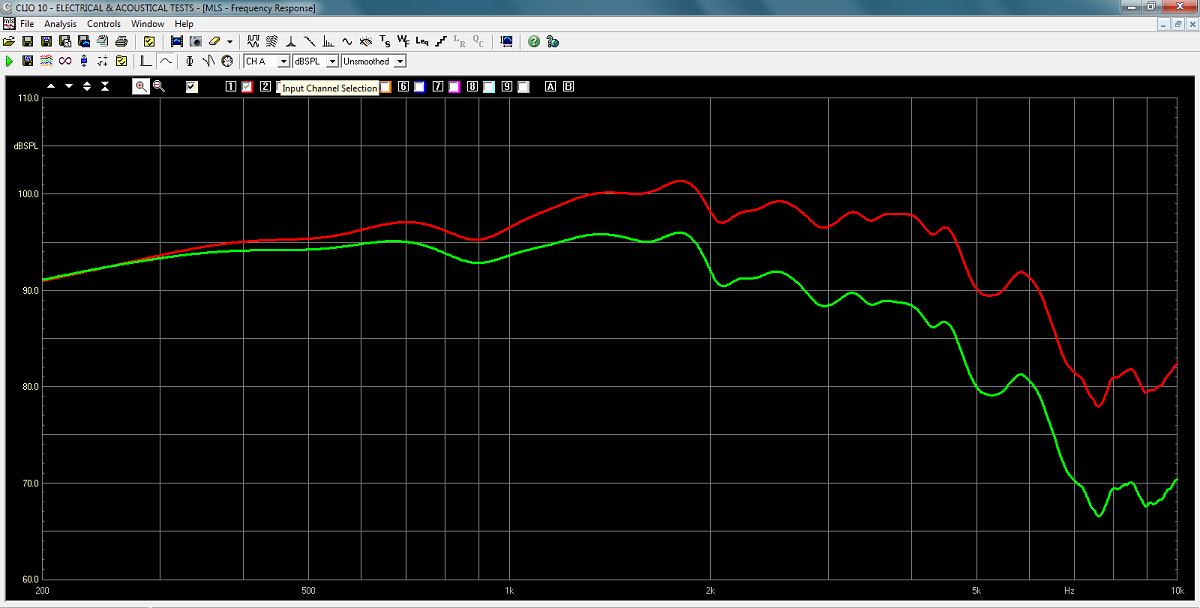
Above a CLIO screen shot from the 8008-HMQ mounted in the DTQWT mkIII cabinet. Red is without filter, green is 1.0 mH in series with the driver. No smoothing applied.
TS data JA8008-HMQ driver
BACK TO INDEX
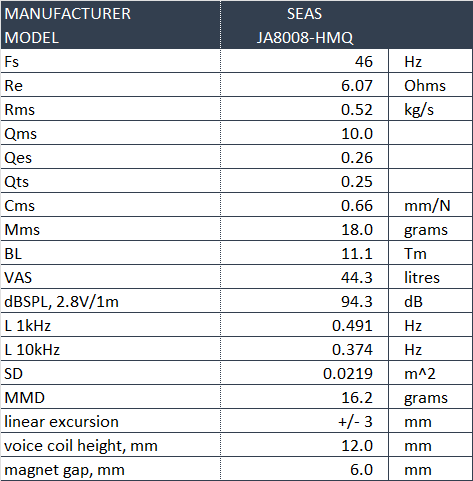
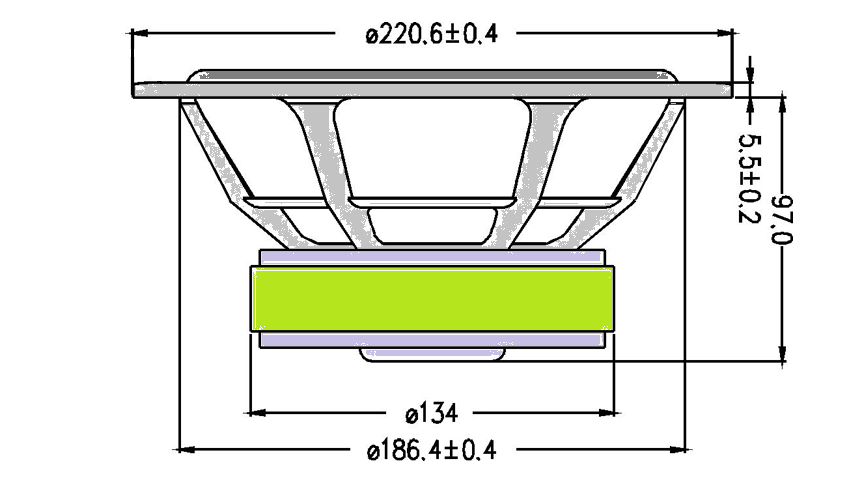
Physical dimensions for the JA8008-HMQ driver. The tolerances have to be
considered. Most of the drivers I've had at hand
have some 220.8-220.9 mm diameter. As always: Never route for drivers
before having them at hand.
Should you want to use the new driver for your own creations
you can obviously buy
the JA8008-HMQ driver from Jantzen Audio.
Please contact Jantzen Audio at
contact@jantzen-audio.com
Technical questions: contact
troels.gravesen@hotmail.com
